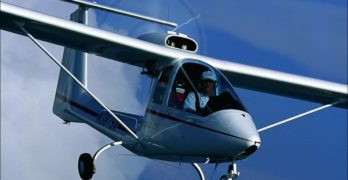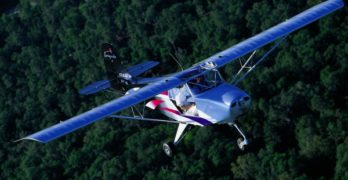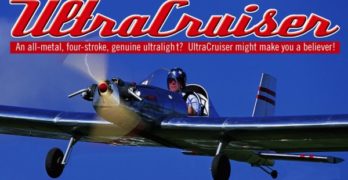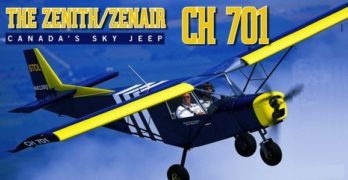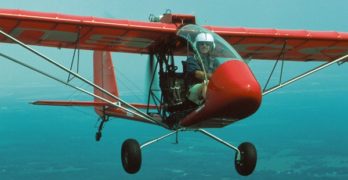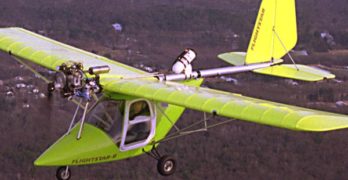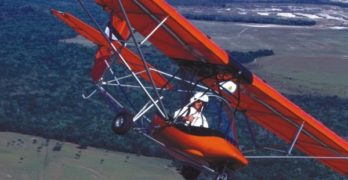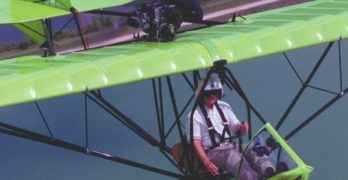SkyStar reorganizes to offer ultralights, homebuilts and special LSAs under “one” roof.
For the new SkyStar Aircraft Corp., the light at the end of the proverbial tunnel is not a locomotive; it’s the coming of a bright new day in light aviation. As the publication of the final sport pilot and light-sport aircraft (SP/LSA) rule looms on the horizon, business is looking better for SkyStar and most other manufacturers and suppliers of light aviation equipment.
The two-place SkyStar Series 7 will have multiple personalities. SkyStar Sport Planes will manufacture a variation of this model as a ready-to-fly special LSA. Depending on the parameters of the final rule, SkyStar Sport Planes may sell an experimental LSA kit (more than 51-percent complete). When flown as an LSA, the Series 7 will be limited to the Rotax 912S engine as its powerplant. SkyStar Aircraft will continue to offer the Series 7 as a 51- percent amateur-built kit, with a variety of engine options, including the 914 Turbo version shown here.
Search Results for : Rotax electric
Not finding exactly what you expected? Try our advanced search option.
Select a manufacturer to go straight to all our content about that manufacturer.
Select an aircraft model to go straight to all our content about that model.
Shooting Across the Sky
Italy’s Sky Arrow makes its mark in the United States
Just as it is home to many fine sports cars, Italy is also home to some beautiful light aircraft-the Sky Arrow being one. The tandem two-seat airplane is designed and manufactured there by Iniziative Industriali Italiane S.p.A (III). Formerly known as Meteor, the company was started in 1947 and also manufactures gliders, airplanes, and remotely piloted vehicles.
Pacific Aerosystem Inc., of San Diego, California, is the United States importer of the Sky Arrow line. With more than 200 Sky Arrows flying worldwide and 25 in the United States, III is an experienced manufacturer and able to meet customer needs, reports Pacific Aerosystem, an important factor to consider when choosing an aircraft.
Currently, Pacific Aerosystem sells four ready-to-fly versions of the Sky Arrow. A kit version can be built under the experimental amateurbuilt rule. Powerplants and instrumentation delineate the models. An 80-hp Rotax 912 powers the 650 TCN and 560 T models.
On An Escapade
Just Aircraft’s Excapade … certificated in England and ready for sport pilots!
Southwestern Idaho has long been a hub of aircraft activity. With ranches and towns settled in great distances, it’s not surprising that aviation, once an established mode of transportation, quickly became popular in that part of the west. It’s also not surprising, then, that the area has been a hub of aircraft building activity. Here’s the story of one aircraft that’s evolved from that heritage.
In 1983, a two-seat, steel tube and fabric aircraft called the Avid Flyer made its first appearance at EAA’s annual convention. Describing the new design in the October 1983 issue of EAA Sport Aviation, then editor Jack Cox wrote, “Dan Denney of Boise, Idaho, was the person with the idea from which sprang the Avid Flyer. He wanted ‘something between ultralights and homebuilts’|(and) Dan had a friend uniquely qualified to transform that (idea) into|an airplane, Dean Wilson.”
What Denney and Wilson demonstrated to the fly-in crowd that year might be called the forerunner of the pending light-sport aircraft category|even at a time when ultralights were still gaining their foothold.
Product Lines – March 1995
ST. PAUL, MINN. — Does hang gliding need to reach out for new enthusiasts? The question raises bothersome issues about declining and aging memberships, but is nonetheless a valid concern. ••• Industry leader, Wills Wing, is doing something about it by starting a new "division." They call it ProLine and its their vehicle to sell certain accessory items. Nothing new about this, you say? True, but Wills expects to do more than sell varios to their WW-brand customers. "It is our intention to use ProLine to develop products that can be marketed OUTSIDE the hang gliding industry", says a recent statement in their dealer newsletter. Naturally, they expect to raise their revenues but they further hope to increase hang gliding exposure to the public. They plan to advertise "in high circulation action sports pubications" once they have a "well developed product line." Each ProLine shipment will eventually have the USHGA color flier as well as the name of the closest WW dealer school.
All-metal, Four-stroke, Genuine Ultralight
The new light-sport aircraft (LSA) category will soon be a reality. While a best guess is that FAA’s newest rules could be announced at EAA AirVenture Oshkosh later this month, it may happen later in the year. Whenever it happens, and like many others watching closely, I hope this new concept arrives swiftly with its promise of interesting aircraft at affordable prices.
As important as LSA may be, however, the proposed new the rule doesn’t affect other enjoyable flying machines. Aircraft built under the amateur-built (51-percent) rule will continue to be a major factor. Many EAA members are building under this rule, and these aircraft will continue to offer wide choices, performance beyond that of many general aviation aircraft, and the pride of craftsmanship. LSA also leaves room for Part 103 ultralights to continue and grow. While some industry leaders see little demand for single-seat aircraft powered by small engines-and it is true that they do not make up a majority of machines-neither, however, will they disappear.
Canada’s Sky Jeep
Pilots will go to great lengths to fly airplanes they like. I went to the Czech Republic to fly the CH 701. That’ s a long way, and I did like the airplane. The experience tells a story of light-sport aircraft development that may become increasingly common.
Like most light plane pilots, I’ve long been familiar with the designs of Swiss-born engineer Chris Heintz. His many aircraft models have put some 2,000 builders in the air. The low-wing, Piper Cherokee-like CH 601 is far and away the most popular air plane he’s designed, with it representing more than 60 percent of all Zenith models sold. Yet, perhaps the most distinctive-looking design he’s offered is the short takeoff and landing (STOL) capable CH 701, the subject of our discussion this month. Now the world grows smaller with Heintz’s Canadian designs being manufactured in the Czech Republic and freighted to the United States for fun in the sky.
Ultralight Trainer from RANS
“RANS is back!”
said many ultralight enthusiasts when the company offered their production version of the S-17 Stinger in September, 1999. Now the Kansas company has reaffirmed their commitment to the ultralight community by offering an enlarged S-17 with an added, tandem seat. Welcome to the S-18 Stinger II.
Of course this isn’t the first ultralight trainer from RANS. They continue to sell their S-12XL Airaile 2-seater. Others may observe that the S-6 Coyote 2-place can be built to operate within the limits of the Part 103 training exemption.
But when RANS first talked about their single-place Stinger – the prototype model that was never marketed – the company had been going in another direction. In those days the apparent darling of the company was the S-16 Shekari that is more accurately described as competition for Van’s RV series than as an ultralight. RANS president Randy Schlitter was able to see that ultralights didn’t simply grow up and become “light aircraft.” And, since Schlitter wants a share of the ultralight community, the S-17 single-place Stinger was his 1999 entry to entice ultralight flyers to the RANS brand name.
The First Two Ultralights with the New HKS Engine
It isn’t often I can do “scouting party” duty on engines. Powerplants aren’t normally my focus. They
are a necessity for flight, but they aren’t my main attraction. A great many pilots I’ve met appear to be just the reverse: They are extremely interested in engines.
I enjoyed the chance to fly behind the first European and first American installations of the new 60-hp HKS 700E 4-stroke from Japan’s HKS Company Ltd. With that in mind, this pilot’s report is rather different. We’ll look at this new engine on two different aircraft.
As all Ultralight Flying! readers know, Rotax has enjoyed great success for more than a decade as an ultralight engine supplier. After dominating the 2-stroke market, Rotax introduced the 81-hp Rotax 912 4-stroke, which has become a popular powerplant choice for sport aviation aircraft.
Is a 4-Stroke Better?
All 4-stroke engine manufacturers trumpet their advantages over 2-strokes: lower fuel consumption, quieter operation, longer time between overhaul, and reliability.
Getting Up On A Breese
A M-Squared solidifies its position in the ultralight industry, the company rounds out its line of models with a pair of single-seaters to complement two 2-seaters already completed.
Welcome to fresh Mississippi Breeses.
M-Squared was born of a collaboration of 17-year Quicksilver veteran Paul Mather, and South Mississippi Light Aircraft (SMLA) owner Ronnie Smith. Mather started and solely owns M-Squared, but the two men have established a complementary working relationship.
Ronnie Smith and his wife built their SMLA operation into a regional powerhouse, selling Quicksilvers and other models through a chain of subdealers. Smith also established the southern enterprise as one of the few official American Rotax sales and service outlets and is also a supplier of many ultralight accessory items.
Mather conceived how Smith’s presence in the business might be combined with his own depth of experience and M-Squared rose as powerfully as the early 80-hp Rotax 912-equipped aircraft he debuted in the spring of 1997.
Golden Circle Air’s T-Bird I Is Easy On Pilots
Ten years ago, in the spring of ’93, I flew and reported on the nosewheel T-Bird I. Part 103 was barely 10 years old then and Sport Pilot/Light-Sport Aircraft concepts were a decade in the distant future.
This month we’re going to take a look at the taildragger T-Bird model. The good news through this passage of time is that the T-Bird I remains a delightful aircraft to fly. Anyone entering ultralight aviation should consider this plane among the fleet of possibilities.
Maybe you’re a bit overwhelmed by the steady stream of talk about FAA’s proposed Light-Sport Aircraft rule. The concept may be a bright light on the aviation horizon, but with another 6 months or more to wait, the patience of many pilots is wearing thin.
Even though I’m excited about this proposed new class of aircraft, I remain a true believer in the lighter, simpler, less expensive theory of ultralight aircraft.
- « Previous Page
- 1
- …
- 26
- 27
- 28
- 29
- 30
- …
- 36
- Next Page »



